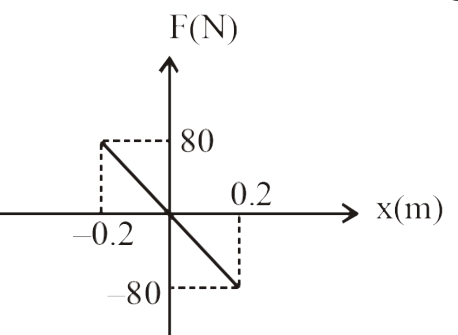A body executes simple harmonic motion under the action of a force F1 with a time period 45s . If the force is changed to F2, it executes SHM with time period 35s. If both the forces F1andF2 act simultaneously in the same direction on the body, its time period (in seconds) is
1225
2425
3524
2512
The correct Answer is:A
To solve the problem, we need to find the time period of a body executing simple harmonic motion (SHM) when two forces, F1 and F2, act simultaneously. Given the time periods associated with each force, we can use the relationship between the time period and the force.
1. Understand the relationship between time period and force:
The time period T of a body in SHM is inversely proportional to the square root of the force acting on it. This can be expressed mathematically as:
T∝1√F
or
T2∝1F
2. Set up the equations for the two forces:
Let T1 be the time period for force F1 and T2 be the time period for force F2.
- Given T1=45 seconds for force F1
- Given T2=35 seconds for force F2
3. Write the equations for the forces:
From the relationship, we can express the forces in terms of the time periods:
F1=k⋅1T21andF2=k⋅1T22
where k is a constant.
4. Calculate the forces:
- For F1:
F1=k⋅1(45)2=k⋅2516
- For F2:
F2=k⋅1(35)2=k⋅259
5. Find the combined force:
When both forces act simultaneously, the total force F is:
F=F1+F2=k⋅2516+k⋅259
To combine these, we need a common denominator, which is 144:
F=k(25⋅9144+25⋅16144)=k⋅25(9+16)144=k⋅25⋅25144=k⋅625144
6. Calculate the new time period T:
Using the relationship T2∝1F:
T2=kF=k⋅144625
Since T21=kF1 and T22=kF2, we can find the new time period T:
T=√144625⋅T1=√144625⋅45
T=1225⋅45=48125 seconds
Final Answer:
The time period of the body when both forces F1 and F2 act simultaneously is 48125 seconds.
The time period T of a body in SHM is inversely proportional to the square root of the force acting on it. This can be expressed mathematically as:
T∝1√F
or
T2∝1F
Let T1 be the time period for force F1 and T2 be the time period for force F2.
- Given T1=45 seconds for force F1
- Given T2=35 seconds for force F2
From the relationship, we can express the forces in terms of the time periods:
F1=k⋅1T21andF2=k⋅1T22
where k is a constant.
- For F1:
F1=k⋅1(45)2=k⋅2516
- For F2:
F2=k⋅1(35)2=k⋅259
When both forces act simultaneously, the total force F is:
F=F1+F2=k⋅2516+k⋅259
To combine these, we need a common denominator, which is 144:
F=k(25⋅9144+25⋅16144)=k⋅25(9+16)144=k⋅25⋅25144=k⋅625144
Using the relationship T2∝1F:
T2=kF=k⋅144625
Since T21=kF1 and T22=kF2, we can find the new time period T:
T=√144625⋅T1=√144625⋅45
T=1225⋅45=48125 seconds
The time period of the body when both forces F1 and F2 act simultaneously is 48125 seconds.
Similar Questions
A body executes SHM under the influence of one force and has a period T1 seconds and the same body executes SHM with period T2 seconds when under the influence of another force. When both forces act simultaneously and in the same direction, then the time period of the same body (in seconds) is:
View SolutionA body of mass 0.01 kg executes simple harmonic motion about x = 0 under the influence of a force as shown in figure. The time period of SHM is

View Solution
Knowledge Check
A particle executing simple harmonic motion with time period T. the time period with which its kinetic energy oscillates is
ATB2TC4TDT2A particle executing simple harmonic motion with an amplitude 5 cm and a time period 0.2 s. the velocity and acceleration of the particle when the displacement is 5 cm is
A0.5πms−1,0ms−2B0.5ms−1,−5π2ms−2C0ms−1,−5π2ms−2D0.5πms−1,−0.5π2ms−2
A body of mass 0.01 kg executes simple harmonic motion (SHM) about x=0 under the influence of a force shown in the figure. The period of the SHM is

View SolutionA body has a time of 3 s under the action of one force and 4 s under the action of another force. Calculate the time period when both the forces act in the same direction simultaneously. Assume that the body undergoes the same displacement, under the action of the two different forces.
View SolutionA particle executing simple harmonic motion has amplitude of 1m and time period 2s. At t=0, net force on the particle is zero. Find the equation of displacement of the particle.
View SolutionA particle executes SHM with a time period of 4s. Find the time taken by the particle to go directly from its mean position to half of its amplitude.
View SolutionA body is at rest under the action of three forces, two of which are →F1=4ˆi,→F2=6ˆj, the third force is
View SolutionA particle has a time period of 1s under the action of a certain force and 2 s under the action of another force. Find the time period when the forces are acting in the same direction simultaneously.
View Solution
